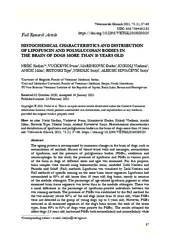Приказ основних података о документу
Histochemical characteristics and distribution of lipofuscin and polyglucosan bodies in the brain of dogs more than 10 years old
Histohemijske karakteristike i distribucija lipofuscina i poliglukozanskih tela u mozgu pasa starijih od 10 godina
| dc.creator | Nešić, Slađan | |
| dc.creator | Vučićević, Ivana | |
| dc.creator | Marinković, Darko | |
| dc.creator | Kukolj, Vladimir | |
| dc.creator | Aničić, Milan | |
| dc.creator | Ristoski, Trpe | |
| dc.creator | Nikolić, Sonja | |
| dc.creator | Aleksić-Kovačević, Sanja | |
| dc.date.accessioned | 2021-06-23T08:41:11Z | |
| dc.date.available | 2021-06-23T08:41:11Z | |
| dc.date.issued | 2021 | |
| dc.identifier.issn | 0350-2457 (Print) | |
| dc.identifier.issn | 2406-0771 (Online) | |
| dc.identifier.uri | https://vet-erinar.vet.bg.ac.rs/handle/123456789/2075 | |
| dc.description.abstract | The ageing process is accompanied by numerous changes in the brain of dogs, such as accumulation of amyloid, fibrosis of blood vessel walls and meninges, accumulation of lipofuscin, and the presence of polyglucosan bodies (PGBs), satellitosis and neuronophagia. In this study, the presence of lipofuscin and PGBs in various parts of the brain in dogs of different sexes and ages was examined. For this purpose, brain samples were stained using haematoxylin eosin, modified Ziehl Neelsen and Periodic acid Schiff (PAS) methods. Lipofuscin was visualised by Ziehl Neelsen and PAS methods of specific staining on the same brain tissue segments. Lipofuscin had accumulated in 93% of old (more than 10 years old) dog brains, mostly in neurons of the medulla oblongata. The percentage of age-related lipofuscin pigment in other examined brain tissue segments was lower than in the medulla oblongata. There was a small difference in the percentage of lipofuscin-positive individuals between the two staining methods. The presence of PGBs was established by the PAS method for the vast majority (about 93%) of the old dogs (more than 10 years old), while PGBs were not detected in the group of young dogs (up to 5 years old). However, PGBs occurred in all examined segments of the dog’s brain tissues (for each of the tissue types, from 90% to 93% of dogs were positive for PGBs). The results obtained the oldest dogs (15 years old) harboured PGBs both extracellularly and intracellularly, while in other dogs, only extracellular PGBs were seen. Lipofuscin was accumulated mostly in large neurons of olivary nuclei of the medulla oblongata. PGBs were confirmed in all examined segments of the brain tissue of dogs more than 10 years old. This is one of the numerous indications that old dogs could be a very good animal model for studying the normal ageing process or neurodegenerative diseases. | |
| dc.description.abstract | Proces starenja prate brojne promene u mozgu pasa kao što su nagomilavanje amiloida, fibroza zida krvnih sudova i moždanih ovojnica, nakupljanje lipofuscina i prisustvo poliglukoznih tela (PGB), satelitoza i neuronofagija. U ovom radu ispitivano je prisustvo lipofuscina i PGB u različitim delovima centralnog nervnog sistema kod pasa različitog pola i starosti. Uzorci mozga obojeni su hematoksilin eozinom, modifikovanom Ziehl Neelsen metodom i perjodna kiselina-Schiff (PAS) metodom. Lipofuscin je modifikovanom Ziehl Neelsen i PAS metodom specifično dokazan u istim segmentima moždanog tkiva. Dobijeni rezultati pokazuju da je lipofuscin akumuliran uglavnom u neuronima produžene moždine kod 93% pasa. Zastupljenost pigmenta u ostalim segmentima mozga bio je niži u poređenju sa produženom moždinom. Korišćenjem obe metode bojenja, ustanovljena je mala razlika u procentu pozitivnih jedinki. Prisustvo PGB dokazano je PAS metodom kod velikog broja (oko 93%) pasa eksperimentalne grupe, dok u kontrolnoj grupi njihovo prisustvo nije ustanovljeno. U svim ispitivanim segmentima moždanog tkiva kod pasa iz eksperimentalne grupe, dokazana su PGB i to od 90% do 93%. Dobijeni rezultati ukazuju da su kod najstarijih pasa iz eksperimentalne grupe PGB bila lokalizovana i van ćelije i unutar nje, a kod drugih samo ekstracelularno. Lipofuscin je akumuliran uglavnom u velikim neuronima olivarnih jedara produžene moždine. PGB su dokazana u svim ispitivanim segmentima moždanog tkiva pasa starijih od 10 godina. Ovo je jedan od brojnih dokaza da stari psi predstavljaju dobar animalni model za proučavanje normalnog procesa starenja ili neurodegenerativnih bolesti. | |
| dc.publisher | Univerzitet u Beogradu - Fakultet veterinarske medicine, Beograd | |
| dc.relation | info:eu-repo/grantAgreement/MESTD/inst-2020/200143/RS// | |
| dc.rights | openAccess | |
| dc.rights.uri | https://creativecommons.org/licenses/by/4.0/ | |
| dc.source | Veterinarski Glasnik | |
| dc.subject | dog | |
| dc.subject | ageing process | |
| dc.subject | brain | |
| dc.subject | lipofuscin | |
| dc.subject | polyglucosan bodies | |
| dc.subject | pas | |
| dc.subject | proces starenja | |
| dc.subject | mozak | |
| dc.subject | lipofuscin | |
| dc.subject | poliglukozanska tela | |
| dc.title | Histochemical characteristics and distribution of lipofuscin and polyglucosan bodies in the brain of dogs more than 10 years old | |
| dc.title | Histohemijske karakteristike i distribucija lipofuscina i poliglukozanskih tela u mozgu pasa starijih od 10 godina | |
| dc.type | article | en |
| dc.rights.license | BY | |
| dcterms.abstract | Aлексић-Ковачевић, Сања; Ристоски, Трпе; Николић, Соња; Кукољ, Владимир; Aничић, Милан; Нешић, Слађан; Вучићевић, Ивана; Маринковић, Дарко; Хистохемијске карактеристике и дистрибуција липофусцина и полиглукозанских тела у мозгу паса старијих од 10 година; | |
| dc.citation.volume | 75 | |
| dc.citation.issue | 1 | |
| dc.citation.spage | 57 | |
| dc.citation.epage | 68 | |
| dc.identifier.fulltext | https://vet-erinar.vet.bg.ac.rs/bitstream/id/5672/bitstream_5672.pdf | |
| dc.identifier.rcub | https://hdl.handle.net/21.15107/rcub_veterinar_2075 | |
| dc.type.version | publishedVersion |

